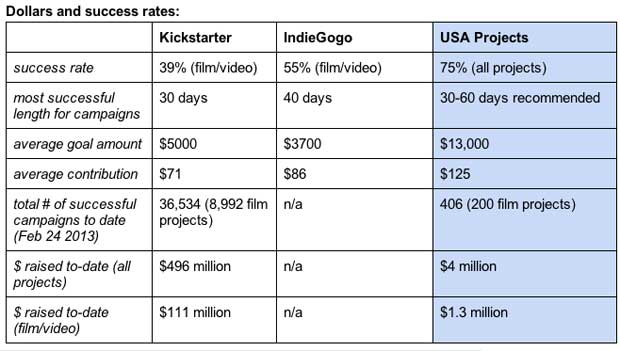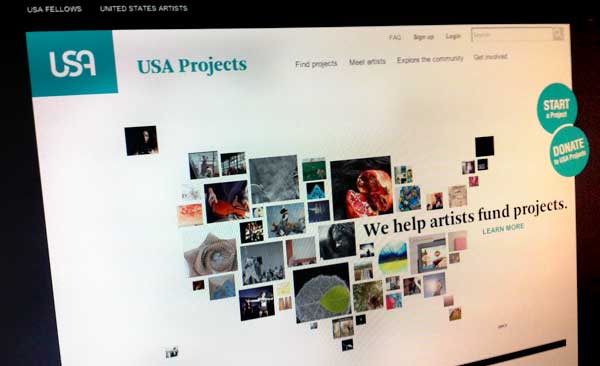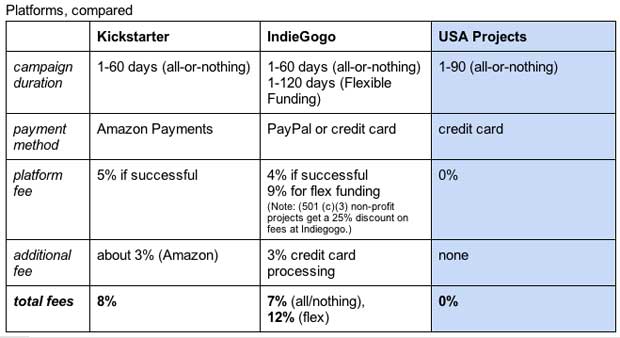USA Projects (Crowdfunding comparison shopping, Pt. II)
Last December I launched this blog with a side-by-side comparison of two of the biggest crowdfunding platforms, as seen from a filmmaker’s perspective (that filmmaker being me, a guy who is currently planning to shoot his first crowd-funded film later this year. It’s a sci-fi short called NEW and you can read about it here).
In part 2, I’ll be focusing solely on the USAprojects.org platform.
One aspect of USA Projects that immediately distinguishes it from Kickstarter and Indiegogo (and most other crowdfunding sites out there) is the fact that it is vetted. All artists on the site are there by invitation only. For that reason, this article will be of most interest to that subset of filmmakers and artists who have secured an invitation and for whom using USA Projects is an option. The rest of you Googlers may want to click on your merry way, with my best wishes.
USA Projects is an outgrowth of United States Artists, a nonprofit grantmaking and artist advocacy organization that annually awards thousands of dollars in grants to artists in a number of disciplines, including literature, performance, and visual art. The USA Projects crowdfunding platform, like its founding body, is a non-profit 501(3)(c) and so donors will be able to claim a tax deduction if they contribute to your film.
Participation in USA Projects is by invitation only; it’s a curated site. Because I received a cash award in 2009 from the Arts Council of Sonoma County, I was invited to participate. When that invitation came, I was already planning the details of my first-ever crowdfunded film project, most likely destined for Kickstarter.com. Suddenly, I had a decision to make. At the time of writing this entry, I still do.
One factor every prospective crowdfunder must consider are the fees. Kickstarter and Indiegogo collect a percentage (between 4–9%) of all funds raised. That’s how they make their money. And at the time I was invited, USA Projects was collecting a whopping 19%! This was a potential deal-breaker for me. If I raised $25,000 on the site to make a film, for instance, I’d be docked nearly five grand right out of the gate. But just two days ago, USA Projects announced they were dropping ALL FEES for artists using the site. They don’t even pass on the credit card charges. Artists keep every dollar they raise. That’s huge.
So, on the subject of fees at least, we have a clear winner. More winning: they kick in matching funds. Some of that money comes from USA Projects, some from the arts organizations they are partner with. No other crowdfunding site I know of offers this. Artists can expect to receive dollar for dollar matches at a rate of “2% to 52% per project, but 16% on average.”
For neophyte crowdfunders like me, the Kickstarter and Indiegogo sites offer plenty of resources. Videos and articles offer lots of tips for running a successful campaign. But USA Projects goes further and actively consults with you in planning and promoting your project. You are assigned an Artist Relations Specialist who takes phone meetings with you through every phase of your project. (Mine is named Sarah, and we’ve already had our first 45-minute consult. She seems very nice.)

Kickstarter is very forthcoming with statistical info. For Indiegogo, numbers are harder to come by. For both Kickstarter and Indiegogo, film or video projects are about 25% of all the campaigns on each site. USA Projects is much smaller – a boutique operation by comparison – but nearly half the projects there are films.
Then there is the matter of success rate. USA Projects uses the all-or-nothing model common in the crowdfunding world: projects must raise their stated target amount or the project fails and no money changes hands. Fully 75% of projects launched on USA Projects succeed in making their goal. That’s impressive, more so even when stacked up next to other sites (see chart).
So what’s the bad news?
Why haven’t I made what seems like an easy choice, if it appears there is no downside to choosing USA Projects?
The answer, of course, is that there is. The downside: USA Projects is not well-known. A crowdfunding campaign lives or dies based on the traffic going to its home page. The Kickstarter community of users is huge, and networked to social media in a big way. Kickstarter.com sees hundreds of thousands of visitors every day and upwards of 2 million page views. For Indiegogo, it’s more like tens of thousands of visitors. I don’t have web traffic statistics for USA Projects; but I’d bet it’s another order of magnitude lower. Witness the social media numbers: Kickstarter’s Twitter account has 634,000 followers, Indiegogo’s, 42,000. USA Projects has 644. The Facebook numbers follow the same pattern, with Kickstarter’s page getting 468,981 likes, with 66,985 for Indiegogo and 9,040 for USA Projects.
A bright spot: because USA Project only hosts a few hundred projects total, your chances of being featured on their home page, or on one of their weekly email blasts is much higher. But considering the low traffic numbers, it’s undeniable: at USA Projects fewer eyes will see your project page. The chances of strangers stumbling across it are lower. Your chances of going viral are lower. The onus is on the filmmaker to spread the word about their project to sympathetic ears.
But then, the onus is always on the filmmaker. Thus is the way of crowdfunding. No matter what platform we choose, my partners and I will be actively, fervently promoting our effort to our personal networks of family, friends, and fellow creatives, and counting on them for (if statistics hold true) roughly half of the money we hope to raise.
But what about the other half? Will enough sympathetic strangers and friends-of-friends-of friends find their way to us to make up the difference? My film, NEW, is an ambitious project. We’re planning to set our goal somewhere between $20,000 and $30,000. Considering that, USA Projects is in fact well-suited in some ways: higher average goal amounts, and higher average contributions. And then, there’s that little voice in my ear saying, “75% success rate…”
Is our project compelling enough to draw people to the site? Will people be biased about donating to a project on a crowd-funding site they’ve never heard of? How big of an incentive will tax-deductible donations be? These question are unanswerable. So, how can I make this decision?
What would you do, if you were me?
I welcome your comments.
: : :
Postscript: Decision made. Check out my USA Projects page, live as of March 29, 2013!
Post-postscript: On May 17, 2013 our film NEW made its fundraising goal. By the time the campaign ended we had raised $22,115. Of that total, $16,915 came from individual donors, to whom we owe a debt of gratitude (and some perks, to be delivered). $5200 came from USA Projects itself, awarded in the form of matching funds. For that we are also grateful…
Post-Post-Postscript: (Fall 2013) USA Projects has re-branded itself as Hatchfund.


Thanks for this. Anything we can do to demystify the process so that more films can be made, the better.
LikeLike
I think you should go with the crowd funding site that has the highest success rate. As you mentioned the responsibility always lies with the filmmaker to promote and fund the film. If average folks are put off by a crowd funding site they have never heard of they are less likely to donate, but those who are familiar with these sites will likely open up to a new site with greater potential. As mentioned above as the traffic goes down the greater the average donation.
LikeLike
Not only the highest success rate, Sam, but look at the huge difference in average goal amount and average contribution size. One could conclude that USA Projects is the right place to go to raise a 5-figure budget for a film. Thanks for your comment.
LikeLike
Further ammo for that argument: here are 4 USA Projects Films going to SxSW this month, among them, Andrew Bujalski’s COMPUTER CHESS, which raised over $50,000 on USA Projects: http://www.unitedstatesartists.org/spotlights/article8/article8.html
LikeLike
Thank you for this article. I’m trying to fund a project, and have delayed the start due to this frustration of where to go. I was accepted at USA Projects, but shyed away due to the 19%. Thank you for this information, now I’m back to completely confused again 🙂
LikeLike
Hi John,
I think I would go with USA Projects. I believe its always up to the film makers to market themselves anyway.
I wonder what the % is of the KS and IGG followers who actually donate to projects based on the project alone, not their relationship to the creators…?
But even still – it sounds like way more support and 75% is hard to ignore….
Good luck and I look forward to hearing out it turns out for you.
LikeLike